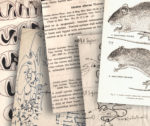Reflexiones acerca del «reasilvestramiento» en la Argentina
María de las Mercedes Guerisoli, Mauro I. Schiaffini, Pablo Teta, Alejandro E.J. Valenzuela, Patricia Mirol, Guillermo E. Defossé, María Marcela Godoy, Pablo Krieger, Tomás Whittington, María G. Agostini, Christopher B. Anderson, Melina Anello, Gustavo Aprile, Jesica E. Aquino, M. Antonella Argoitia, Yanina Arzamendia, Julián E.M. Baigorria, Diego Baldo, Jorge L. Baldo, Ulises Balza, Ian Barbe, Diego A. Barrasso, Fernando R. Barri, M. Noelia Barrios-Garcia, Cristina Bartolucci, Ricardo O. Bastida, Gabriel Bauer, Pablo Berrozpe, Claudio Bertonatti, Roberto F. Bó, Julio C. Bracamonte, Denise H. Campo, Mariana Cannizzo, Pablo Carmanchahi, Flavia Caruso, Flavia Cassinelli, Silvia C. Chalukian, Mario L. Chatellenaz, M. Amelia Chemisquy, Mariana Cosse, Griet A.E. Cuyckens, Romina L. D'Agostino, Valeria C. D'Agostino, Guillermo Deferrari, Mariana Degrati, Hebe del Valle Ferreyra, Enrique J. Derlindati, Sophia Di Cataldo, Florencia Di Rocco, Jael Dominino, Cristian A. Durante, Elena B. Eder, Sofía M. Esquenazi, M. Cecilia Ezquiaga, Julián Faivovich, Fernando J. Fernández, Nicolás Ferreyra, Francisco Firpo Lacoste, David Flores, Anahí E. Formoso, Marcello Franchini, Eduardo E. Francisco, María J. Gómez Fernández, Baltazar González, Enrique M. González, Susana González, José C. Guerrero, Agustín N. Guiscafré, Ernesto E. Juan, Marta S. Kin, Martín Kowalewski, María G. Laitán, Cecilia Lanzone, Gabriel Laufer, Carmen Leizagoyen, M. Soledad Leonardi, Rocío Loizaga, Fernando J. Mapelli, Gabriel M. Martin, Guillermina Massaccesi, María S. Merani, Julián Mignino, Carolina I. Miño, M. Daniela Miotti, Alejandro Morici, Flavio N. Moschione, Patricia A. Mosti, Norberto Muzzachiodi, Javier Nori, Agustina Novillo, Agustina A. Ojeda, Luciana I. Oklander, M. Marcela Orozco, Ramiro Ovejero, Andrés G. Palmerio, María N. Paso Viola, Hernán Pastore, Lorena M. Paszko, Lorena C. Pérez Carusi, Pablo G. Perovic, Alejandro Perretta, Carla M. Pozzi, Héctor E. Ramírez-Chaves, María A. Relva, Juan I. Reppucci, Facundo Robino, Mariano A. Rodríguez-Cabal, Lucía I. Rodríguez-Planes, Ignacio Roesler, Luis F. Rossi, Valentina Segura, Claudio Sillero-Zubiri, Florencia Sittoni, Andrés Tálamo, Julio C. Torres Monges, Alejandro Travaini, Juan I. Túnez, Daniel E. Udrizar Sauthier, Marcela M. Uhart, José H. Urquizo, Oscar E. Vargas, Guillermo M. Wiemeyer, Marina Winter, Laura I. Wolfenson, Ricardo Ojeda
